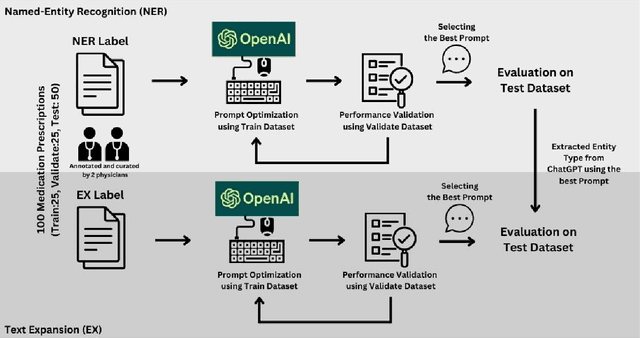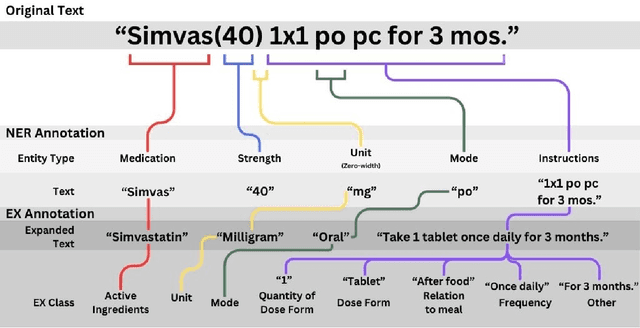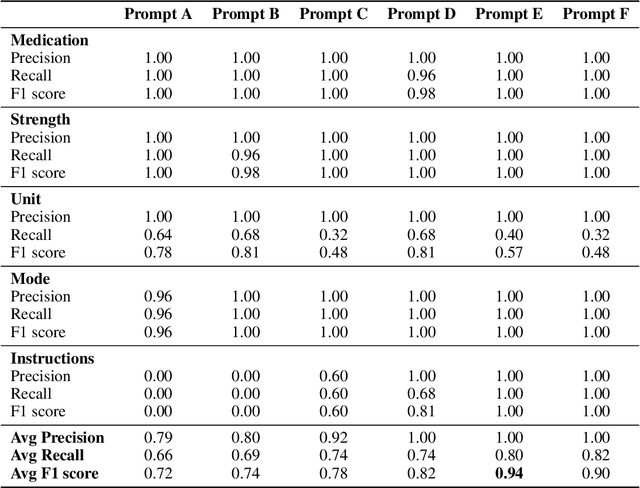Medical Named Entity Recognition
Medical named entity recognition is the process of identifying and categorizing medical terms or entities in text data.
Papers and Code
Pre-trained Language Models and Few-shot Learning for Medical Entity Extraction
Apr 06, 2025This study proposes a medical entity extraction method based on Transformer to enhance the information extraction capability of medical literature. Considering the professionalism and complexity of medical texts, we compare the performance of different pre-trained language models (BERT, BioBERT, PubMedBERT, ClinicalBERT) in medical entity extraction tasks. Experimental results show that PubMedBERT achieves the best performance (F1-score = 88.8%), indicating that a language model pre-trained on biomedical literature is more effective in the medical domain. In addition, we analyze the impact of different entity extraction methods (CRF, Span-based, Seq2Seq) and find that the Span-based approach performs best in medical entity extraction tasks (F1-score = 88.6%). It demonstrates superior accuracy in identifying entity boundaries. In low-resource scenarios, we further explore the application of Few-shot Learning in medical entity extraction. Experimental results show that even with only 10-shot training samples, the model achieves an F1-score of 79.1%, verifying the effectiveness of Few-shot Learning under limited data conditions. This study confirms that the combination of pre-trained language models and Few-shot Learning can enhance the accuracy of medical entity extraction. Future research can integrate knowledge graphs and active learning strategies to improve the model's generalization and stability, providing a more effective solution for medical NLP research. Keywords- Natural Language Processing, medical named entity recognition, pre-trained language model, Few-shot Learning, information extraction, deep learning
Fine-Tuning LLMs on Small Medical Datasets: Text Classification and Normalization Effectiveness on Cardiology reports and Discharge records
Mar 27, 2025We investigate the effectiveness of fine-tuning large language models (LLMs) on small medical datasets for text classification and named entity recognition tasks. Using a German cardiology report dataset and the i2b2 Smoking Challenge dataset, we demonstrate that fine-tuning small LLMs locally on limited training data can improve performance achieving comparable results to larger models. Our experiments show that fine-tuning improves performance on both tasks, with notable gains observed with as few as 200-300 training examples. Overall, the study highlights the potential of task-specific fine-tuning of LLMs for automating clinical workflows and efficiently extracting structured data from unstructured medical text.
Leveraging Semantic Type Dependencies for Clinical Named Entity Recognition
Mar 07, 2025



Previous work on clinical relation extraction from free-text sentences leveraged information about semantic types from clinical knowledge bases as a part of entity representations. In this paper, we exploit additional evidence by also making use of domain-specific semantic type dependencies. We encode the relation between a span of tokens matching a Unified Medical Language System (UMLS) concept and other tokens in the sentence. We implement our method and compare against different named entity recognition (NER) architectures (i.e., BiLSTM-CRF and BiLSTM-GCN-CRF) using different pre-trained clinical embeddings (i.e., BERT, BioBERT, UMLSBert). Our experimental results on clinical datasets show that in some cases NER effectiveness can be significantly improved by making use of domain-specific semantic type dependencies. Our work is also the first study generating a matrix encoding to make use of more than three dependencies in one pass for the NER task.
Efficient extraction of medication information from clinical notes: an evaluation in two languages
Feb 05, 2025



Objective: To evaluate the accuracy, computational cost and portability of a new Natural Language Processing (NLP) method for extracting medication information from clinical narratives. Materials and Methods: We propose an original transformer-based architecture for the extraction of entities and their relations pertaining to patients' medication regimen. First, we used this approach to train and evaluate a model on French clinical notes, using a newly annotated corpus from H\^opitaux Universitaires de Strasbourg. Second, the portability of the approach was assessed by conducting an evaluation on clinical documents in English from the 2018 n2c2 shared task. Information extraction accuracy and computational cost were assessed by comparison with an available method using transformers. Results: The proposed architecture achieves on the task of relation extraction itself performance that are competitive with the state-of-the-art on both French and English (F-measures 0.82 and 0.96 vs 0.81 and 0.95), but reduce the computational cost by 10. End-to-end (Named Entity recognition and Relation Extraction) F1 performance is 0.69 and 0.82 for French and English corpus. Discussion: While an existing system developed for English notes was deployed in a French hospital setting with reasonable effort, we found that an alternative architecture offered end-to-end drug information extraction with comparable extraction performance and lower computational impact for both French and English clinical text processing, respectively. Conclusion: The proposed architecture can be used to extract medication information from clinical text with high performance and low computational cost and consequently suits with usually limited hospital IT resources
KU AIGEN ICL EDI@BC8 Track 3: Advancing Phenotype Named Entity Recognition and Normalization for Dysmorphology Physical Examination Reports
Jan 16, 2025The objective of BioCreative8 Track 3 is to extract phenotypic key medical findings embedded within EHR texts and subsequently normalize these findings to their Human Phenotype Ontology (HPO) terms. However, the presence of diverse surface forms in phenotypic findings makes it challenging to accurately normalize them to the correct HPO terms. To address this challenge, we explored various models for named entity recognition and implemented data augmentation techniques such as synonym marginalization to enhance the normalization step. Our pipeline resulted in an exact extraction and normalization F1 score 2.6\% higher than the mean score of all submissions received in response to the challenge. Furthermore, in terms of the normalization F1 score, our approach surpassed the average performance by 1.9\%. These findings contribute to the advancement of automated medical data extraction and normalization techniques, showcasing potential pathways for future research and application in the biomedical domain.
Cross-Lingual Transfer for Low-Resource Natural Language Processing
Feb 04, 2025Natural Language Processing (NLP) has seen remarkable advances in recent years, particularly with the emergence of Large Language Models that have achieved unprecedented performance across many tasks. However, these developments have mainly benefited a small number of high-resource languages such as English. The majority of languages still face significant challenges due to the scarcity of training data and computational resources. To address this issue, this thesis focuses on cross-lingual transfer learning, a research area aimed at leveraging data and models from high-resource languages to improve NLP performance for low-resource languages. Specifically, we focus on Sequence Labeling tasks such as Named Entity Recognition, Opinion Target Extraction, and Argument Mining. The research is structured around three main objectives: (1) advancing data-based cross-lingual transfer learning methods through improved translation and annotation projection techniques, (2) developing enhanced model-based transfer learning approaches utilizing state-of-the-art multilingual models, and (3) applying these methods to real-world problems while creating open-source resources that facilitate future research in low-resource NLP. More specifically, this thesis presents a new method to improve data-based transfer with T-Projection, a state-of-the-art annotation projection method that leverages text-to-text multilingual models and machine translation systems. T-Projection significantly outperforms previous annotation projection methods by a wide margin. For model-based transfer, we introduce a constrained decoding algorithm that enhances cross-lingual Sequence Labeling in zero-shot settings using text-to-text models. Finally, we develop Medical mT5, the first multilingual text-to-text medical model, demonstrating the practical impact of our research on real-world applications.
Accurate Medical Named Entity Recognition Through Specialized NLP Models
Dec 11, 2024


This study evaluated the effect of BioBERT in medical text processing for the task of medical named entity recognition. Through comparative experiments with models such as BERT, ClinicalBERT, SciBERT, and BlueBERT, the results showed that BioBERT achieved the best performance in both precision and F1 score, verifying its applicability and superiority in the medical field. BioBERT enhances its ability to understand professional terms and complex medical texts through pre-training on biomedical data, providing a powerful tool for medical information extraction and clinical decision support. The study also explored the privacy and compliance challenges of BioBERT when processing medical data, and proposed future research directions for combining other medical-specific models to improve generalization and robustness. With the development of deep learning technology, the potential of BioBERT in application fields such as intelligent medicine, personalized treatment, and disease prediction will be further expanded. Future research can focus on the real-time and interpretability of the model to promote its widespread application in the medical field.
On Fusing ChatGPT and Ensemble Learning in Discon-tinuous Named Entity Recognition in Health Corpora
Dec 22, 2024Named Entity Recognition has traditionally been a key task in natural language processing, aiming to identify and extract important terms from unstructured text data. However, a notable challenge for contemporary deep-learning NER models has been identifying discontinuous entities, which are often fragmented within the text. To date, methods to address Discontinuous Named Entity Recognition have not been explored using ensemble learning to the best of our knowledge. Furthermore, the rise of large language models, such as ChatGPT in recent years, has shown significant effectiveness across many NLP tasks. Most existing approaches, however, have primarily utilized ChatGPT as a problem-solving tool rather than exploring its potential as an integrative element within ensemble learning algorithms. In this study, we investigated the integration of ChatGPT as an arbitrator within an ensemble method, aiming to enhance performance on DNER tasks. Our method combines five state-of-the-art NER models with ChatGPT using custom prompt engineering to assess the robustness and generalization capabilities of the ensemble algorithm. We conducted experiments on three benchmark medical datasets, comparing our method against the five SOTA models, individual applications of GPT-3.5 and GPT-4, and a voting ensemble method. The results indicate that our proposed fusion of ChatGPT with the ensemble learning algorithm outperforms the SOTA results in the CADEC, ShARe13, and ShARe14 datasets, showcasing its potential to enhance NLP applications in the healthcare domain.
An Experimental Study on Data Augmentation Techniques for Named Entity Recognition on Low-Resource Domains
Nov 21, 2024Named Entity Recognition (NER) is a machine learning task that traditionally relies on supervised learning and annotated data. Acquiring such data is often a challenge, particularly in specialized fields like medical, legal, and financial sectors. Those are commonly referred to as low-resource domains, which comprise long-tail entities, due to the scarcity of available data. To address this, data augmentation techniques are increasingly being employed to generate additional training instances from the original dataset. In this study, we evaluate the effectiveness of two prominent text augmentation techniques, Mention Replacement and Contextual Word Replacement, on two widely-used NER models, Bi-LSTM+CRF and BERT. We conduct experiments on four datasets from low-resource domains, and we explore the impact of various combinations of training subset sizes and number of augmented examples. We not only confirm that data augmentation is particularly beneficial for smaller datasets, but we also demonstrate that there is no universally optimal number of augmented examples, i.e., NER practitioners must experiment with different quantities in order to fine-tune their projects.
Zero- and Few-shot Named Entity Recognition and Text Expansion in Medication Prescriptions using ChatGPT
Sep 26, 2024



Introduction: Medication prescriptions are often in free text and include a mix of two languages, local brand names, and a wide range of idiosyncratic formats and abbreviations. Large language models (LLMs) have shown promising ability to generate text in response to input prompts. We use ChatGPT 3.5 to automatically structure and expand medication statements in discharge summaries and thus make them easier to interpret for people and machines. Methods: Named-entity Recognition (NER) and Text Expansion (EX) are used in a zero- and few-shot setting with different prompt strategies. 100 medication statements were manually annotated and curated. NER performance was measured by using strict and partial matching. For the task EX, two experts interpreted the results by assessing semantic equivalence between original and expanded statements. The model performance was measured by precision, recall, and F1 score. Results: For NER, the best-performing prompt reached an average F1 score of 0.94 in the test set. For EX, the few-shot prompt showed superior performance among other prompts, with an average F1 score of 0.87. Conclusion: Our study demonstrates good performance for NER and EX tasks in free-text medication statements using ChatGPT. Compared to a zero-shot baseline, a few-shot approach prevented the system from hallucinating, which would be unacceptable when processing safety-relevant medication data.
 Add to Chrome
Add to Chrome Add to Firefox
Add to Firefox Add to Edge
Add to Edge